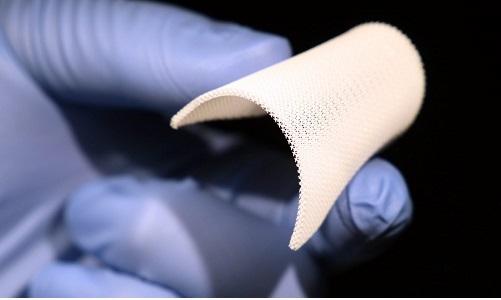- FMA
- The Fabricator
- FABTECH
- Canadian Metalworking
Our Publications
Categories
- Additive Manufacturing
- Aluminum Welding
- Arc Welding
- Assembly and Joining
- Automation and Robotics
- Bending and Forming
- Consumables
- Cutting and Weld Prep
- Electric Vehicles
- En Español
- Finishing
- Hydroforming
- Laser Cutting
- Laser Welding
- Machining
- Manufacturing Software
- Materials Handling
- Metals/Materials
- Oxyfuel Cutting
- Plasma Cutting
- Power Tools
- Punching and Other Holemaking
- Roll Forming
- Safety
- Sawing
- Shearing
- Shop Management
- Testing and Measuring
- Tube and Pipe Fabrication
- Tube and Pipe Production
- Waterjet Cutting
Industry Directory
Webcasts
Podcasts
FAB 40
Advertise
Subscribe
Account Login
Search
Researchers develop process to 3D-print piezoelectric materials
- January 22, 2019
- News Release
- Additive Manufacturing

The process of 3D-printing piezoelectric material developed at Virginia Tech could be the next smart material.
The piezoelectric materials found in everything from cell phones to musical greeting cards may be getting an upgrade thanks to work performed at Virginia Tech’s College of Engineering.
(Piezoelectric materials convert strain and stress into electrical charges.)
Tech assistant professor of mechanical engineering Xiaoyu ‘Rayne’ Zheng and his team have developed methods to 3D-print piezoelectric materials that can be custom-designed to convert movement, impact, and stress from any direction into electrical energy.
Conventional piezoelectric materials come in only a few defined shapes and are made of brittle crystal and ceramic—materials that must be manufactured in a clean room. Zheng’s team has developed a 3D printing technique that doesn’t limit piezo materials in terms of their shape or size.
A factor in current piezoelectric fabrication is the natural crystal used. At the atomic level, the orientation of atoms is fixed. Zheng’s team has produced a substitute that mimics the crystal but allows for the lattice orientation to be altered by design.
Zheng said: “We have synthesized a class of highly sensitive piezoelectric inks that can be sculpted into complex three-dimensional features with ultraviolet light. The inks contain highly concentrated piezoelectric nanocrystals bonded with UV-sensitive gels, which form a solution—a milky mixture like melted crystal—that we print with a high-resolution, digital-light 3D printer.”
The team demonstrated 3D-printed materials at a scale measuring a fraction of the diameter of a human hair. “We can tailor the architecture to make them more flexible and use them, for instance, as energy harvesting devices, wrapping them around any arbitrary curvature,” Zheng said. “We can make them thick and light or stiff and energy-absorbing.”Click here to watch a video of the piezoelectric 3D printing process.
A paper on the Virginia Tech research was published in the journal Nature Materials.
- Podcasting
- Podcast:
- The Fabricator Podcast
- Published:
- 04/16/2024
- Running Time:
- 63:29
In this episode of The Fabricator Podcast, Caleb Chamberlain, co-founder and CEO of OSH Cut, discusses his company’s...
- Trending Articles
- Industry Events
16th Annual Safety Conference
- April 30 - May 1, 2024
- Elgin,
Pipe and Tube Conference
- May 21 - 22, 2024
- Omaha, NE
World-Class Roll Forming Workshop
- June 5 - 6, 2024
- Louisville, KY
Advanced Laser Application Workshop
- June 25 - 27, 2024
- Novi, MI
























